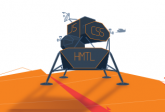Coherent GT1.9 release with new high-level data-binding

Coherent GT 1.9 is here and brings a huge amount of powerful features. In this release, our focus was on easier workflow and high-level features for developers that want to extend further the possibilities of GT.
Update: Check the latest release – Coherent GT 2.0
NEW HIGH-LEVEL DATA-BINDING
The biggest feature in this release is our brand new declarative data-binding feature. It allows UI designers to define with a couple of lines very complex interactions with the game and avoid writing any JavaScript logic. The data-binding works seamlessly behind the scenes and automatically animates and modifies the UI when values change in the game! The new system introduces a model-view relationship between the game and the UI.
Designers can now write HTML like this:
<div data-bind-style-left="{{myModel.leftPos}}"></div>
The data-binding increases dramatically the team productivity and removes the need to manually update the game UI from game events. Performance is also improved because for most properties JavaScript code is not executed and all evaluation happens in C++.
Stay tuned for a blog post that will delve into the details of the system. In the meantime, you can also check our public documentation.
TEST DRIVER FOR SELENIUM
Coherent GT can now work with the Selenium test driver and significantly improve the testing process of the UI. Automated tests can be written in JavaScript or Python and developers are able to easily assure the quality of their game UI. Selenium is the de-facto standard for web development automation and is now available also for game UI development.
An upcoming blog post will explain in detail the features and possibilities that the test driver brings to developers.
CUSTOM EFFECTS SUPPORT
Coherent GT already supports CSS filters and effects, but in certain cases, developers need to do custom effects on the game UI. This is now possible with Coherent GT 1.9 – UI programmers can define effects in CSS and apply them in the game code. Even animated and multi-pass effects can be easily achieved. The custom effects properties are first-class CSS properties that can be modified from JavaScript. Developers are now able to apply effects directly from the game engine to the UI and apply game-specific effects.
PERFORMANCE, API AND PLATFORM IMPROVEMENTS
We have introduced a new API that allows developers to compose the UI in a user-supplied texture and skip an eventual texture copy if they compose their UI directly on the game HUD.
Mac OS X 32-bit libraries have been added for users that have 32-bit engines.
New performance improvements are also available in the release. GT now detects simple layers and doesn’t allocate memory for them, but directly draws them. In some use-cases this can bring significant GPU memory savings.
Stay tuned for our upcoming blog posts on the new data-binding system and the Selenium test driver!
Follow Stoyan on Twitter: @stoyannk



